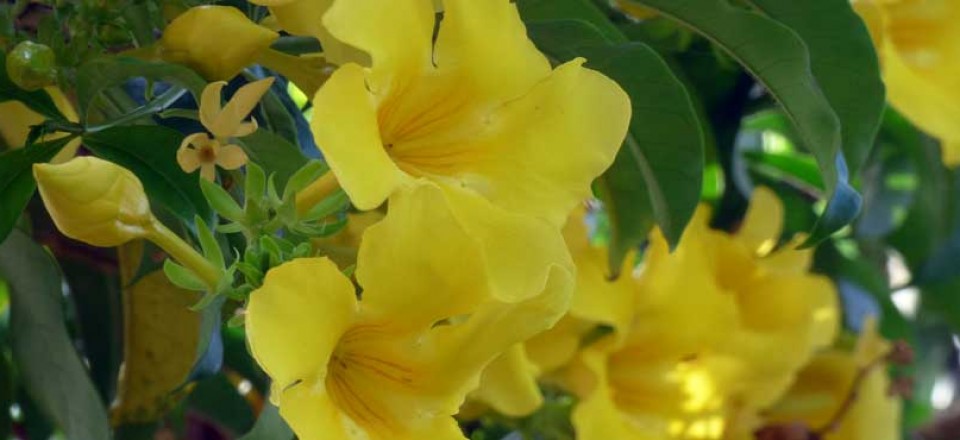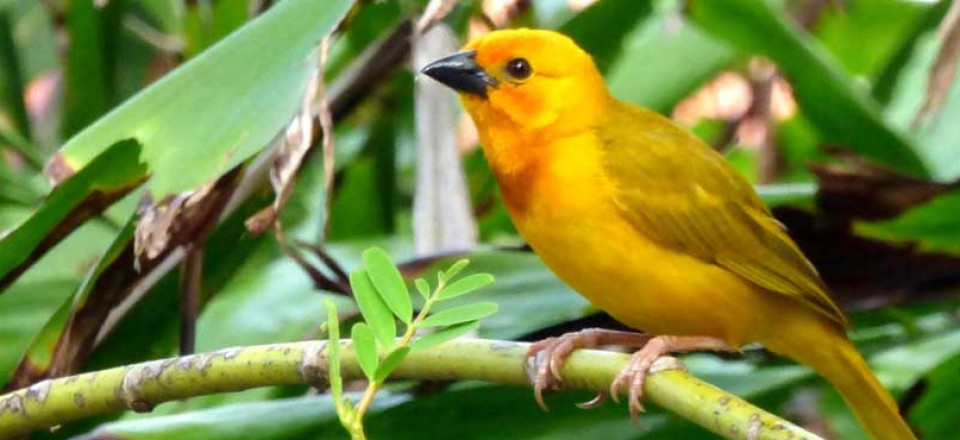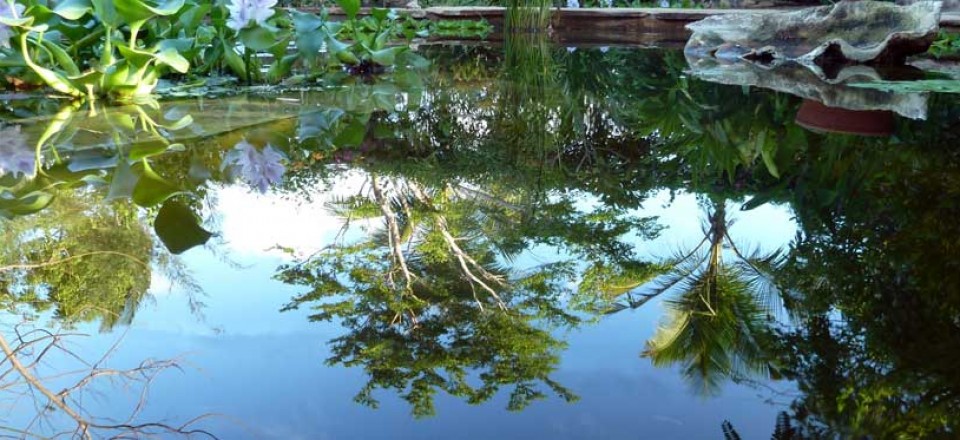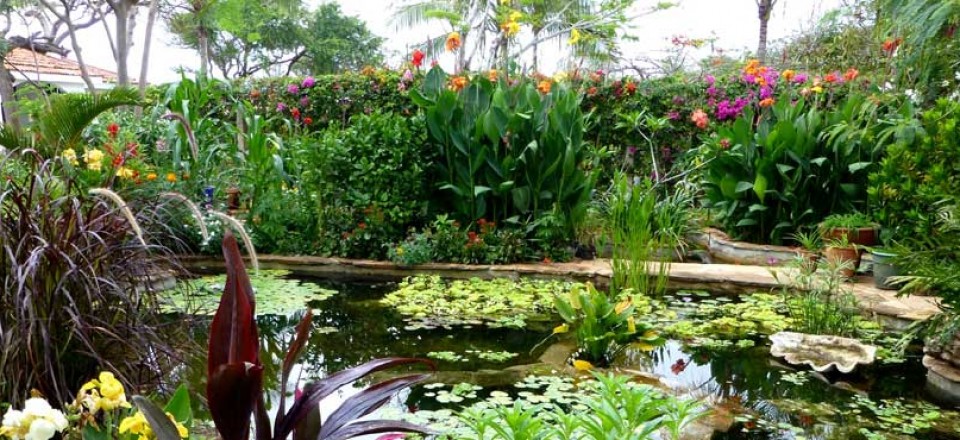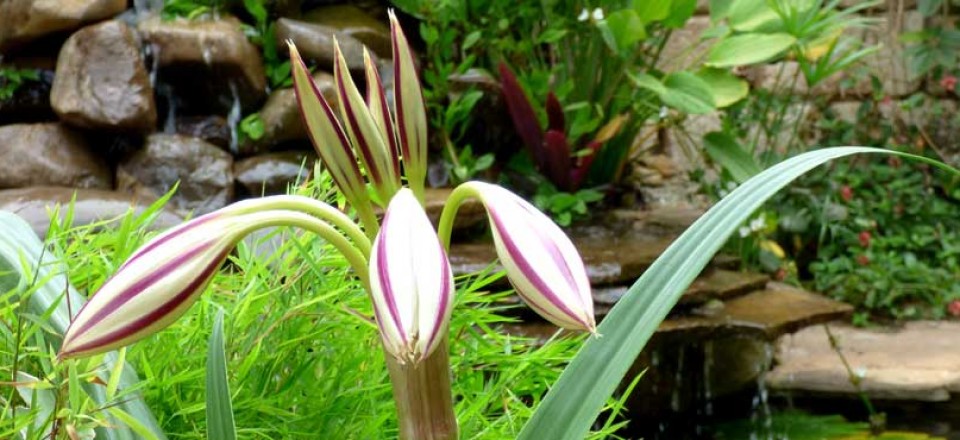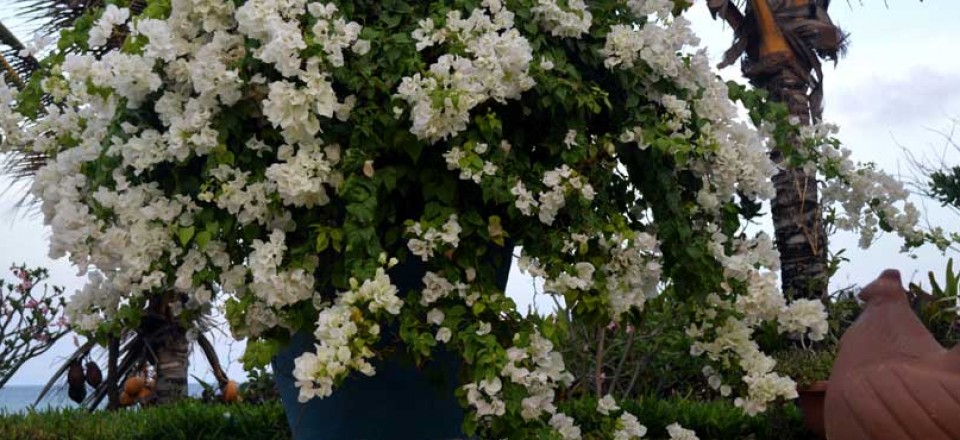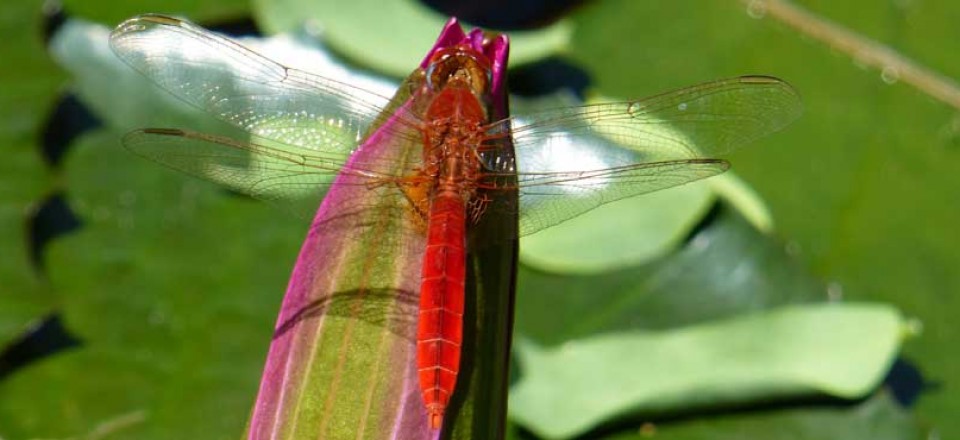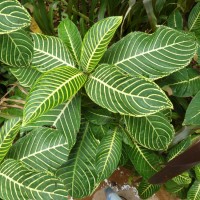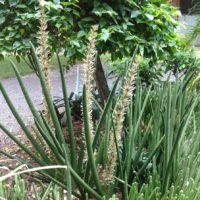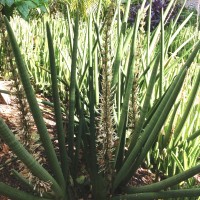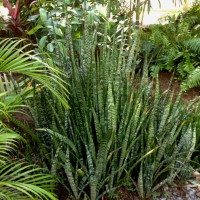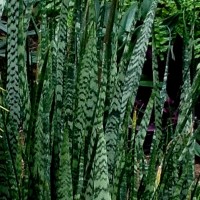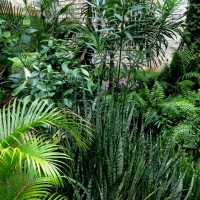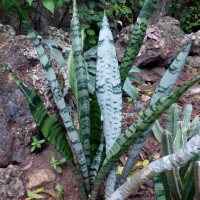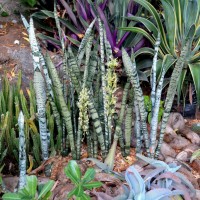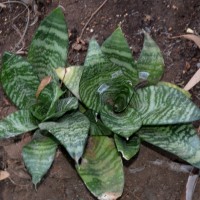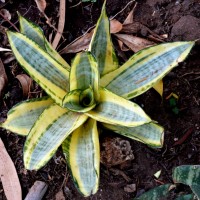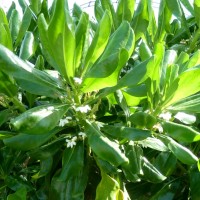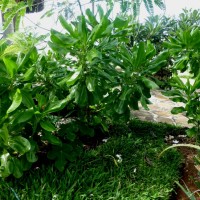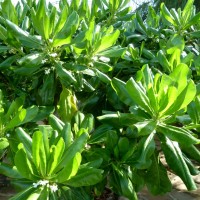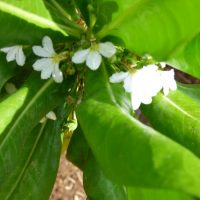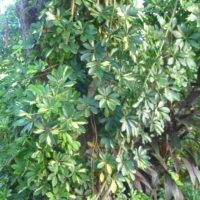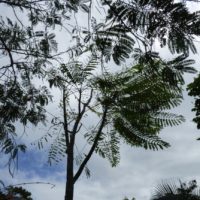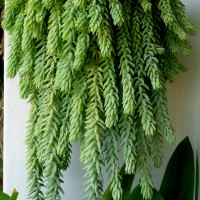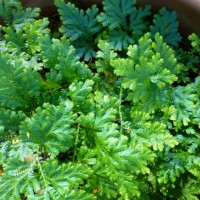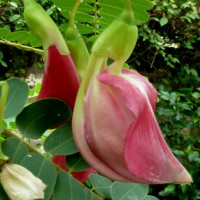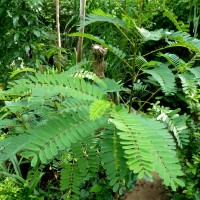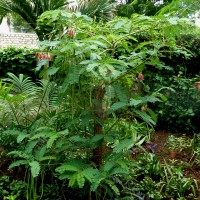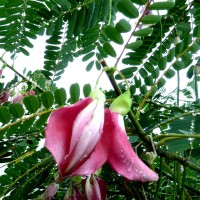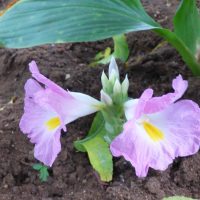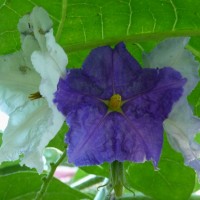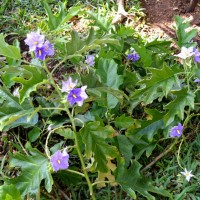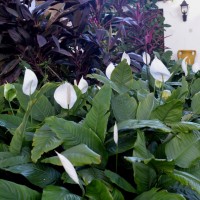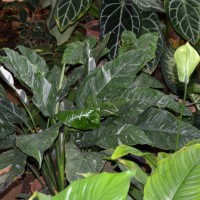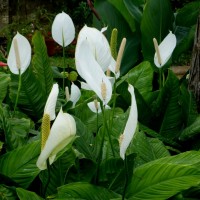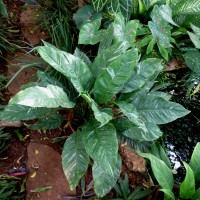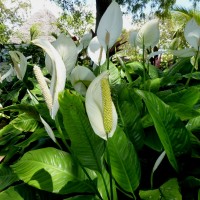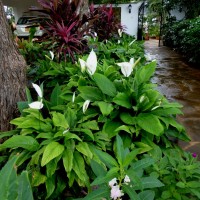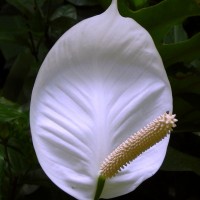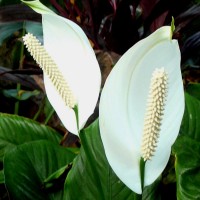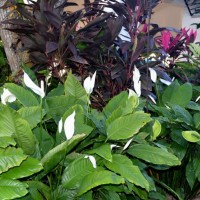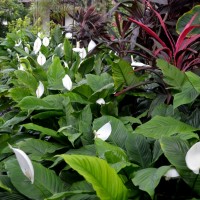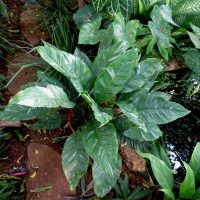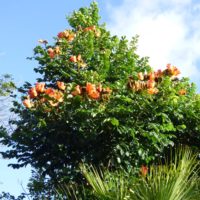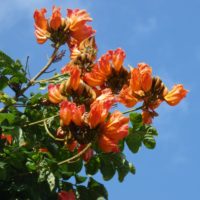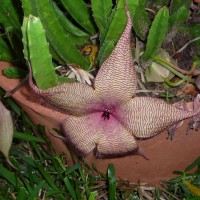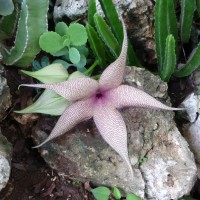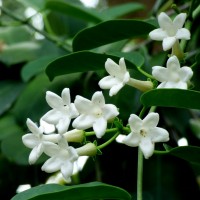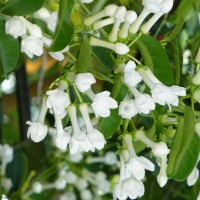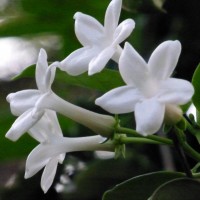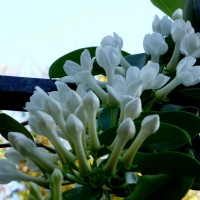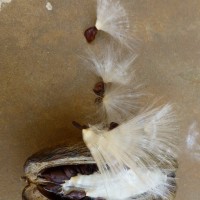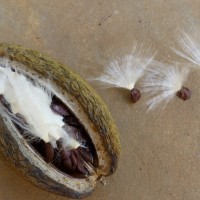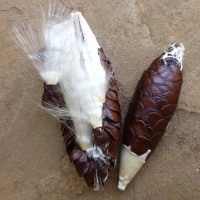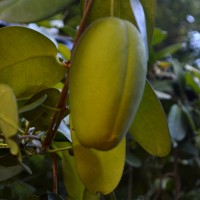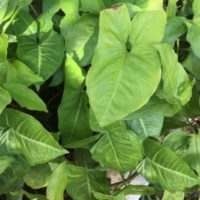SANCHEZIA NOBILIS
Family Acanthaceae
Sanchezia nobilis is named after Josef Sanchez, an early professor of botany at Cadiz in Spain. Sanchezia nobilis flowers from time to time but the beauty of the plant is in the foliage. It doesn’t like full sun, and requires some water. When growing well, it is most attractive, it becomes leggy and needs to be pruned to keep a good shape. Mealybug causing Black Sooty mold can be a problem. Updated 10/9/2018
SANSEVERIA
Family Asparagaceae
Sansevieria is native to Africa, Madagascar and Southern Asia, it was named in honour of the Italian Pietro Antonio Sanseverino and the spelling was changed from Sanseverinia to Sanseveria in 1770. There is a large variation of plants within the group; ranging from tough desert to the slightly tender tropical species.
Sansevieria is a very accommodating plant tolerating low light, poor sandy soil and irregular watering. It is drought tolerant and will die quickly if given too much water. In the garden, it grows happily where few other plants will survive, filling odd spaces, and adding height and colour to otherwise dull areas. NASA states that by absorbing toxins it is one of the best plants for improving indoor air quality. Updated 10/9/2018
Sansevieria cylindrical
Sansevieria grandis
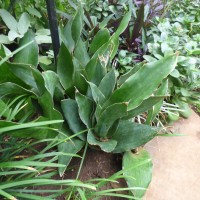
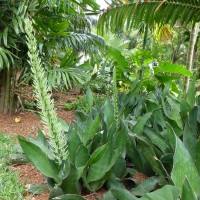
Sansevieria trifasciata
Sansevieria trifasciata hahnii
Sansevieria trifasciata Hahnii is a low growing plant reaching about seven to eight inches tall.
Sansevieria trifasciata Golden Hahnii
SCAEVOLA TACCADA
Family Goodeniaceae
Scaevola taccada is native to the Indian and Pacific Ocean. It is a bush that will grow close to the sea, exposed to salt spray, making it an excellent windbreak; the leaves are never get scorched. It grows under Casuarinas too. Scaevola taccada flowers continually, though the blooms are rather insignificant. The seeds can float in the ocean for up to a year and will still germinate, as long as they are then given fresh water. Updated 10/9/2018
Schefflera arboricola variegatum
Family Araliaceae
Schefflera arboricola variegatum is a plant that needs no special attention, is very poisons plant for humans and animals and can be fatal. It grows easily in the garden, reaching great heights. Updated 10/9/2018
SCHIZOLOBIUM PARAHYBUM
Family Fabaceae
Schizolobium parahyba is a fast growing tropical tree from Brazil (growing 18ft in a year from seed in its Brazilian habitat) that can be pruned to size. Three-foot long fern like leaves that are both light and touch sensitive makes this a very unusual plant. Updated 10/9/2018
SEDUM MORGANIANUM
Family Crassulaceae
Sedum morganianum grows best where it can hang and show off it’s tails. The compost should be a well draining and full of nutrients. It likes to grow in bright light but not full sun. It is drought-tolerant, but likes to be kept moist, though not wet. Updated 10/9/2018
SELAGINELA UNCINATA
Family Selaginellaceae
Selaginella uncinata there are approx 700 species of selaginella native to different climates. It is a primitive seedless vascular plant dating back 410 million years, the plant changes colour from green to iridescent blue in order to reduce the effect of sun beams filtering though the canopy. It is drought-tolerant. Updated 10/9/2018
SELENICEREUS ANTHONYANUS
Family Cactoideae
Selenicereus anthonyanus is native to southern Mexico, it was first found by Dr Harold E Anthony in June 1950. It is fast growing epiphyte that can be grown in semi-shade, but prefers full sun, which encourages flowering. It is a night flowering cacti and the flowers are very fragrant.
SESBANIA GRANDIFLORA
Family Fabaceae
Sesbania grandiflora is named after the father of Tamil literature, Vedic sage Agastyt who, lived between the 6th and 7th centuries BC. Its origins are not certain but it has a long history in India. The seeds germinate easily and the tree grows quickly. As a young tree it is attractive, with the red parrot-shaped flowers (they also come in white). As the tree ages, it becomes less attractive because the long seed pods which dangle down, look like socks on a washing line. It is best to keep replacing with new young trees. Sesbania grandiflora is tolerant of both drought and salinity.
Updated 10/9/2018
SIPHONOCHILUS AETHIOPICUS
Family Zingiberaceae
Siphonochilus aethiopicus is derived from the Greek siphono meaning ‘tube’, and chilus meaning ‘lip’, referring to the shape of the flower, while the specific name aethiopicus means from southern Africa. Siphonochilus aethiopicus is a ginger and, after the rains, it can be found flowering profusely in the wild. During the dry season the leaves wilt and die. It does well in the garden and growing in both full sun and shade. Because of the medicinal value, the plant is over-collected, and is currently listed in the Red Data book of South African plants. Updated 10/9/2018
SOLANUM MACRANTHUM
Solanum wrightii potato tree (name change)
Family Solanaceae
Solanum macranthum, is native to Brazil. It is a fast growing tree and in the right situation can reach a height of 15 feet. It is happier at higher altitudes and struggles at the coast, needing to be kept out of the saline breeze. It will grow from cuttings and seed. Mealybug and Red Spider-mite are a problem. Updated 10/9/2018
SPHAGNETICOLA TRILOBATA
Family Asteraceae
Sphagneticola trilobata is another ‘weed’ for the garden, it makes a thick ground cover with bright yellow flowers. The problem is that once it has been planted in the garden it is difficult to get rid of. It is listed among one of the hundred worst weeds in the world! Updated 10/9/2018
SPATHIPHYLLUM COMMUTATUM
Family Araceae
Spathiphyllum commutatum originates from the bogs of Central America. They are very tolerant and nearly impossible to kill but if they are not cared for, it will show almost immediately. The leaves may curl and the tips will look burnt. Spathiphyllum don’t require huge amounts of water, although it is almost impossible to over-water them. They are happiest in bright light, direct sunlight can harm them. They are hungry plants and best grown in pots, planted in rich compost. They will need to be top dressed at least regularly. Eventually the plant will outgrow the pot, and will need to be re-potted; at which point it may be divided into several new plants. Updated 10/9/2018
SPATHIPHYLLUM WALLISII DOMINO
Spathiphyllum wallisii domino is like Spathiphyllum wallisii, but with variegated leaves that are attractive. It is rather shy about flowering.
SPATHODEA CAMPANULATA
Family Bignoniaceae
Spathodea campanulata (Nandi Flame or Tulip Tree) is native to the tropical dry forests of Equatorial Africa and, rather sadly, has been nominated as one of the 100 “World’s Worst” invaders! It was first discovered in 1787 on the gold Coast of Africa.
This is a fast growing tree and one of the most beautiful to behold at the coast. It does not grow close to the sea although they can put up with some salt. We have two growing in the garden but both are struggling due to the coral, which prevents the tree from extending its roots. Given good deep soil, the tree grows into a huge specimen and flowers abundantly. Updated 10/9/2018
STAPELIA GIGANTEAN
Family Apocynaceae
Stapelia gigantea is a clump forming succulent, which grows in poor soil with small amounts of water. It flowers continually, producing huge blooms that smell of rotting flesh to attract flies to pollinate the them. It is easy to grow and increases at such a rate that lots go on the compost. Updated 10/9/2018
STEPHANOTIS FLORIBUNDA
Family Dogbane
Stephanotis floribunda is native to Madagascar and grows well at the coast, preferring to grow in dappled shade, receiving some sunlight but not in the mid-day. It requires a strong frame to ramble over and throws out flowers most of the year. The seed pods look like small mangoes and take six months to ripen. Scale can be a problem. Propagation is by seed or cuttings. Updated 11/9/2018
SYNGONIUM PODOPHYLLUM
Family Araceae
Syngonium podophyllum is native to Latin America, and is an evergreen climbing plant and grows well up a post. This is an easy plant that needs no special treatment.

